NRCS Recalibration and Wind Speed Retrieval for SWOT KaRIn Radar Data
Abstract
:1. Introduction
2. Data
2.1. SWOT KaRIn
2.2. ECMWF
2.3. HY2C-SCAT
2.4. NDBC and TAO
3. Analysis and Recalibration
4. Model and Retrieval
5. Evaluation
6. Discussion
7. Conclusions
Author Contributions
Funding
Data Availability Statement
Acknowledgments
Conflicts of Interest
References
- Freilich, M.H.; Vanhoff, B.A. The relationship between winds, surface roughness, and radar backscatter at low incidence angles from TRMM precipitation radar measurements. J. Atmos. Ocean. Technol. 2003, 20, 549–562. [Google Scholar] [CrossRef]
- Hersbach, H. Comparison of C-band scatterometer CMOD5.N equivalent neutral winds with ECMWF. J. Atmos. Ocean. Technol. 2010, 27, 721–736. [Google Scholar] [CrossRef]
- Monaldo, F.; Jackson, C.; Li, X.; Pichel, W.G. Preliminary evaluation of sentinel-1a wind speed retrievals. IEEE J. Sel. Top. Appl. Earth Obs. Remote Sens. 2016, 9, 2638–2642. [Google Scholar] [CrossRef]
- Brown, O.B.; Stanley, H.R.; Roy, N.A. The wind speed measurement capability of spaceborne radar altimetry. IEEE J. Ocean. Eng. 1981, 6, 59–63. [Google Scholar] [CrossRef]
- Meissner, T.; Wentz, F.J. The emissivity of the ocean surface between 6 and 90 Ghz over a large range of wind speeds and earth incidence angles. IEEE Trans. Geosci. Remote Sens. 2012, 50, 3004–3026. [Google Scholar] [CrossRef]
- Xu, H.; Han, C.; Wu, Y.; Sun, D.; Wang, X.; Li, J. A probability-constraint-based method for robust wind velocity estimation in lidar doppler spectrograms with low signal-to-noise ratio. IEEE Trans. Geosci. Remote Sens. 2023, 61, 5703310. [Google Scholar] [CrossRef]
- Cox, C.; Munk, W. Measurement of roughness of the sea from photographs of the sun’s glitter. J. Opt. Soc. Am. 1954, 44, 838–850. [Google Scholar] [CrossRef]
- Hwang, P.A.; Stoffelen, A.; Van Zadelhoff, G.J.; Perrie, W.; Zhang, B.; Li, H. Cross-polarization geophysical model function for c-band radar backscattering from the ocean surface and wind speed retrieval. J. Geophys. Res. Ocean. 2015, 120, 893–909. [Google Scholar] [CrossRef]
- Mouche, A.; Chapron, B. Global C-band Envisat, RADARSAT-2 and Sentinel-1 SAR measurements in co-polarization and cross-polarization. J. Geophys. Res. Ocean. 2015, 120, 7195–7207. [Google Scholar] [CrossRef]
- Portabella, M.; Stoffelen, A.; Johannessen, J.A. Toward an optimal inversion method for synthetic aperture radar wind retrieval. J. Geophys. Res. Ocean. 2001, 107, 3086. [Google Scholar] [CrossRef]
- Ren, L.; Yang, J.; Mouche, A. Assessments of ocean wind retrieval schemes used for Chinese Gaofen-3 synthetic aperture radar co-polarized data. IEEE Trans. Geosci. Remote Sens. 2019, 57, 7075–7085. [Google Scholar] [CrossRef]
- Stoffelen, A.; Verspeek, J.A.; Vogelzang, J. The CMOD7 geophysical model function for ASCAT and ERS wind retrievals. IEEE J. Sel. Top. Appl. Earth Obs. Remote Sens. 2017, 10, 2013–2124. [Google Scholar] [CrossRef]
- Zhang, B.; Perrie, W.; Vachon, P.W.; Li, X.; Pichel, W.G.; Guo, J.; He, Y. Ocean vector winds retrieval from c-band fully polarimetric SAR measurements. IEEE Trans. Geosci. Remote Sens. 2012, 50, 4252–4261. [Google Scholar] [CrossRef]
- Valenzuela, G.R. Theories for the interaction of electromagnetic and oceanic waves—A review. Bound.-Layer Meteorol. 1978, 13, 61–85. [Google Scholar] [CrossRef]
- Gourrion, J.; Vandemark, D.; Bailey, S.; Chapron, B.; Gommenginger, G. A two-parameter wind speed algorithm for ku-band altimeters. J. Atmos. Ocean. Technol. 2002, 19, 2030–2048. [Google Scholar] [CrossRef]
- Lillibridge, J.; Scharroo, R.; Abdalla, S. One- and two-dimensional wind speed models for ka-band altimetry. J. Atmos. Ocean. Technol. 2014, 31, 630–638. [Google Scholar] [CrossRef]
- Yang, J.; Zhang, J.; Jia, Y.; Fan, C.; Cui, W. Validation of Sentinel-3A/3B and Jason-3 altimeter wind speeds and significant wave heights using buoy and ASCAT data. Remote Sens. 2020, 12, 2079. [Google Scholar] [CrossRef]
- Tran, N.; Chapron, B.; Vandemark, D. Effect of long waves on Ku-band ocean radar backscatter at low incidence angles using TRMM and altimeter data. IEEE Geosci. Remote Sens. Lett. 2007, 4, 542–546. [Google Scholar] [CrossRef]
- Chu, X.; He, Y.; Chen, G. Asymmetry and anisotropy of microwave backscatter at low incidence angles. IEEE Trans. Geosci. Remote Sens. 2012, 50, 4014–4024. [Google Scholar] [CrossRef]
- Li, L.; Im, E.; Connor, L.N.; Chang, P.S. Retrieving ocean surface wind speed from the TRMM precipitation radar measurements. IEEE Trans. Geosci. Remote Sens. 2004, 42, 1271–1282. [Google Scholar] [CrossRef]
- Ren, L.; Yang, J.; Zheng, G.; Wang, J. Wind speed retrieval from Ku-band tropical rainfall mapping mission precipitation radar data at low incidence angles. J. Appl. Remote Sens. 2016, 10, 016012. [Google Scholar] [CrossRef]
- Ren, L.; Yang, J.; Jia, Y.; Dong, X.; Zheng, G. Sea surface wind speed retrieval and validation of the interferometric imaging radar altimeter aboard the Chinese tiangong-2 space laboratory. IEEE J. Sel. Top. Appl. Earth Obs. Remote Sens. 2018, 11, 4718–4724. [Google Scholar] [CrossRef]
- Ren, L.; Yang, J.; Xu, Y.; Zhang, Y.; Zheng, G.; Wang, J.; Dai, J.; Jiang, C. Ocean surface wind speed dependence and retrieval from off-Nadir CFOSAT SWIM data. Earth Space Sci. 2021, 8, e2020EA001505. [Google Scholar] [CrossRef]
- Panfilova, M.; Karaev, V. Wind speed retrieval algorithm using ku-band radar onboard GPM satellite. Remote Sens. 2021, 13, 4565. [Google Scholar] [CrossRef]
- Jiang, C.; Ren, L.; Yang, J.; Xu, Q.; Dai, J. Wind speed retrieval using global precipitation measurement dual-frequency precipitation radar ka-band data at low incidence angles. Remote Sens. 2022, 14, 1454. [Google Scholar] [CrossRef]
- Yang, J.; Ren, L.; Zheng, G. The first quantitative ocean remote sensing by using Chinese interferometric imaging radar altimeter onboard TG-2. Acta Oceanol. Sin. 2017, 36, 122–123. [Google Scholar] [CrossRef]
- Zhang, Y.; Shi, X.; Wang, H.; Tan, Y.; Jiang, J. Interferometric Imaging Radar Altimeter on Board Chinese Tiangong-2 Space Laboratory. In Proceedings of the 2018 Asia-Pacific Microwave Conference (APMC), Kyoto, Japan, 6–9 November 2018; pp. 851–853. [Google Scholar]
- Li, H.; Mouche, A.; Stopa, J.E.; Chapron, B. Calibration of the normalized radar cross section for sentinel-1 wave mode. IEEE Trans. Geosci. Remote Sens. 2019, 57, 1514–1522. [Google Scholar] [CrossRef]
- Wang, H.; Li, H.; Lin, M.; Zhu, J.; Wang, J.; Li, D.; Cui, L. Calibration of the copolarized backscattering measurements from Gaofen-3 synthetic aperture radar wave mode imagery. IEEE J. Sel. Top. Appl. Earth Obs. Remote Sens. 2019, 12, 911–922. [Google Scholar] [CrossRef]
- Fjørtoft, R.; Gaudin, J.M.; Pourthié, N.; Lalaurie, J.C.; Mallet, A.; Nouvel, J.F.; Martinot-Lagarde, J.; Oriot, H.; Borderies, P.; Ruiz, C.; et al. KaRIn on SWOT: Characteristics of near-nadir ka-band interferometric SAR imagery. IEEE Trans. Geosci. Remote Sens. 2014, 52, 2172–2185. [Google Scholar] [CrossRef]
- Guo, H.; Wan, X.; Wang, H. Validation of just-released SWOT L2 Karin beta prevalidated data based on restore the marine gravity field and its application. IEEE J. Sel. Top. Appl. Earth Obs. Remote Sens. 2024, 17, 7878–7887. [Google Scholar] [CrossRef]
- NASA JPL California Institute of Technolog and CNES. SWOT Product Description Level 2 KaRIn Low Rate Sea Surface Height Product (Revision A); NASA JPL California Institute of Technology and CNES: La Cañada Flintridge, CA, USA, 2022.
- Sheng, Y.; Zhang, L.; Lin, M.; Zou, J.; Mu, B.; Peng, H. Evaluation of sea surface wind products from scatterometer onboard the Chinese HY-2D satellite. Remote Sens. 2023, 15, 852. [Google Scholar] [CrossRef]
- Charnock, H. Wind stress on a water surface. Q. J. R. Meteorol. Soc. 1955, 81, 639–640. [Google Scholar] [CrossRef]
- Smith, S.D. Coefficients for sea surface wind stress, heat flux, and wind profiles as a function of wind speed and temperature. J. Geophys. Res. 1988, 93, 15467–15472. [Google Scholar] [CrossRef]
- Wang, Z.; Stoffelen, A.; Fois, F.; Verhoef, A.; Zhao, C.; Lin, M.; Chen, G. SST dependence of Ku- and C-band backscatter measurements. IEEE J. Sel. Top. Appl. Earth Obs. Remote Sens. 2017, 10, 2135–2146. [Google Scholar] [CrossRef]
- Yan, Q.; Zhang, J.; Fan, C.; Meng, J. Analysis of Ku- and Ka-Band sea surface backscattering characteristics at low-incidence angles based on the GPM dual-frequency precipitation radar measurements. Remote Sens. 2019, 11, 754. [Google Scholar] [CrossRef]
- Chelton, D.B. The sea state bias in altimeter estimates of sea level from collinear analysis of Topex data. J. Geophys. Res. Ocean. 1994, 99, 24995–25008. [Google Scholar] [CrossRef]
- Miao, H.; Jing, Y.; Jia, Y.; Lin, M.; Zhang, G.; Wang, G. Nonparametric estimations of the sea state bias for a radar altimeter. Acta Oceanol. Sin. 2017, 36, 108–113. [Google Scholar] [CrossRef]
- Li, X.; Zhang, B.; Mouche, A.; He, Y.; Perrie, W. Ku-band sea surface radar backscatter at low incidence angles under extreme wind conditions. Remote Sens. 2017, 9, 474. [Google Scholar] [CrossRef]
- Zhang, B.; Zhu, Z.; Perrie, W.; Tang, J.; Zhang, J.A. Estimating tropical cyclone wind structure and intensity from spaceborne radiometer and synthetic aperture radar. IEEE J. Sel. Top. Appl. Earth Obs. Remote Sens. 2021, 14, 4043–4050. [Google Scholar] [CrossRef]
- Mouche, A.A.; Chapron, B.; Zhang, B.; Husson, R. Combined co- and cross-polarized SAR measurements under extreme wind conditions. IEEE Trans. Geosci. Remote Sens. 2017, 55, 6746–6755. [Google Scholar] [CrossRef]
- Vachon, P.W.; Wolfe, J. C-Band cross-polarization wind speed retrieval. IEEE Geosci. Remote Sens. Lett. 2011, 8, 456–459. [Google Scholar] [CrossRef]
- Zhang, G.; Li, X.; Perrie, W.; Hwang, P.A.; Zhang, B.; Yang, X. A hurricane wind speed retrieval model for C-Band RADARSAT-2 cross-polarization ScanSAR images. IEEE Trans. Geosci. Remote Sens. 2017, 55, 4766–4774. [Google Scholar] [CrossRef]
- Liu, S.; Li, Y.; Zhou, W.; Jin, X.; Yang, X.; Dou, H.; Li, H. Ocean surface parameters estimation from microwave radiometer voltages using deep learning. IEEE Trans. Geosci. Remote Sens. 2024, 62, 5300813. [Google Scholar] [CrossRef]
- Cao, C.; Bao, L.; Gao, G.; Liu, G.; Zhang, X. A novel method for ocean wave spectra retrieval using deep learning from Sentinel-1 wave mode data. IEEE Trans. Geosci. Remote Sens. 2024, 62, 4204016. [Google Scholar] [CrossRef]
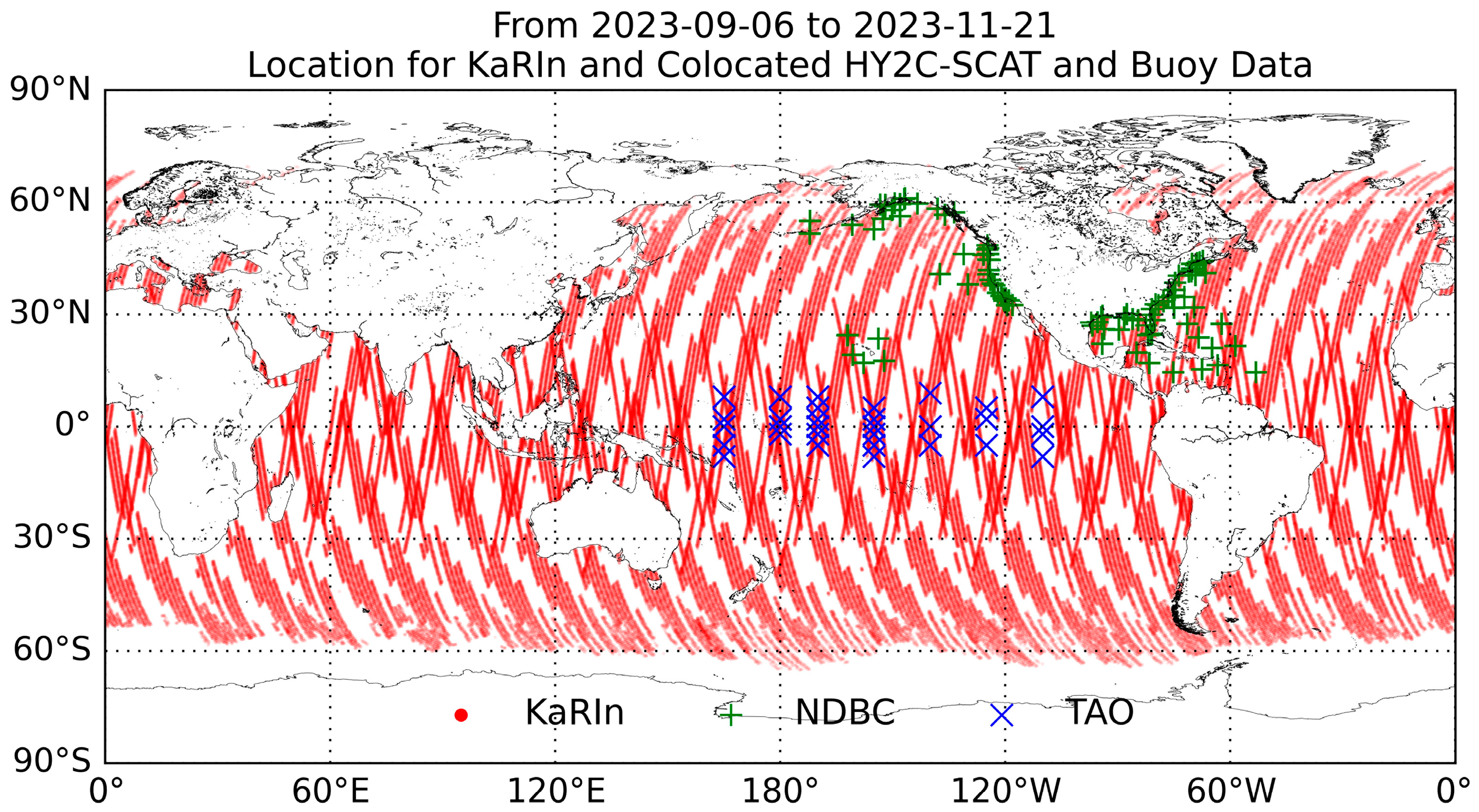


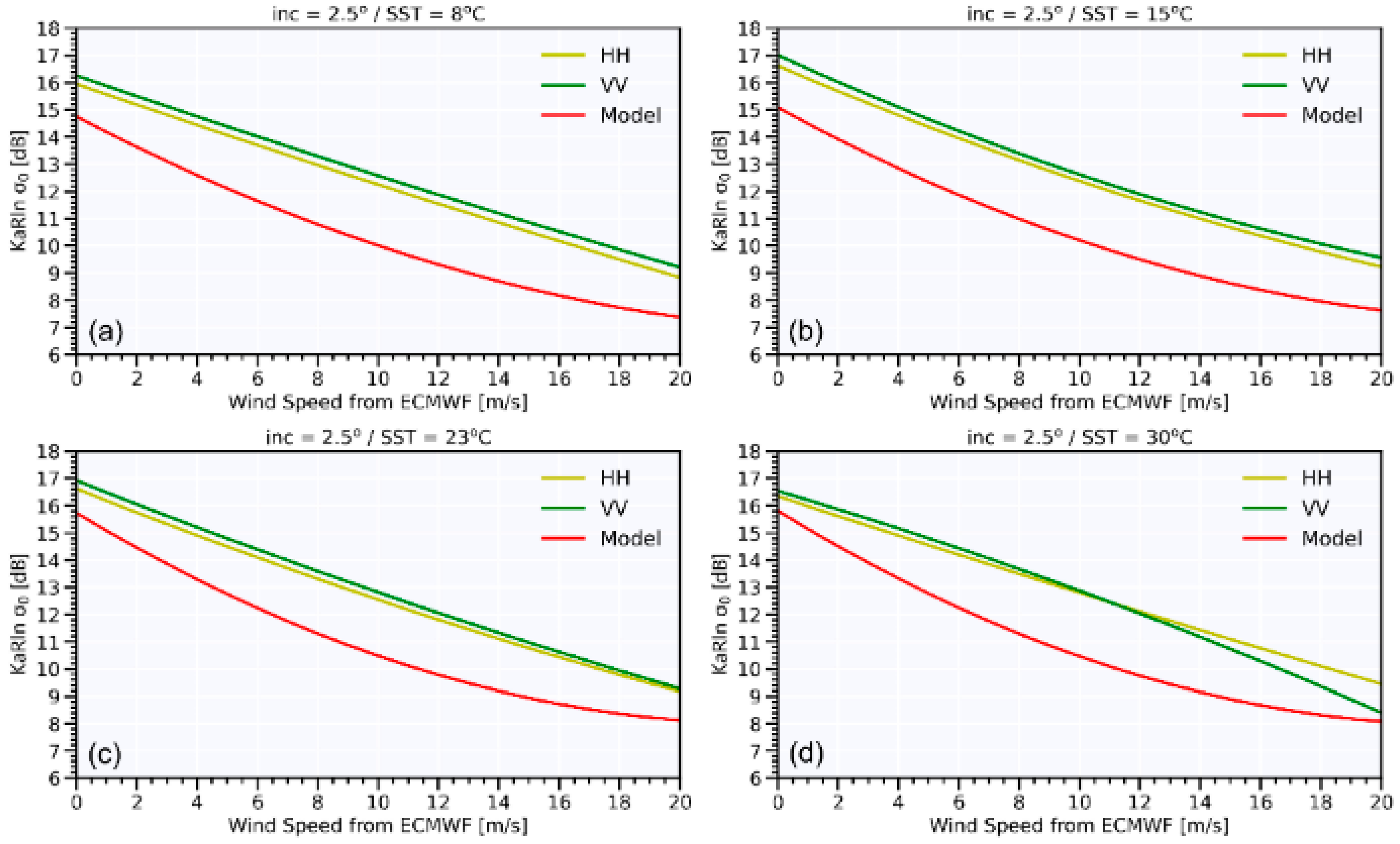
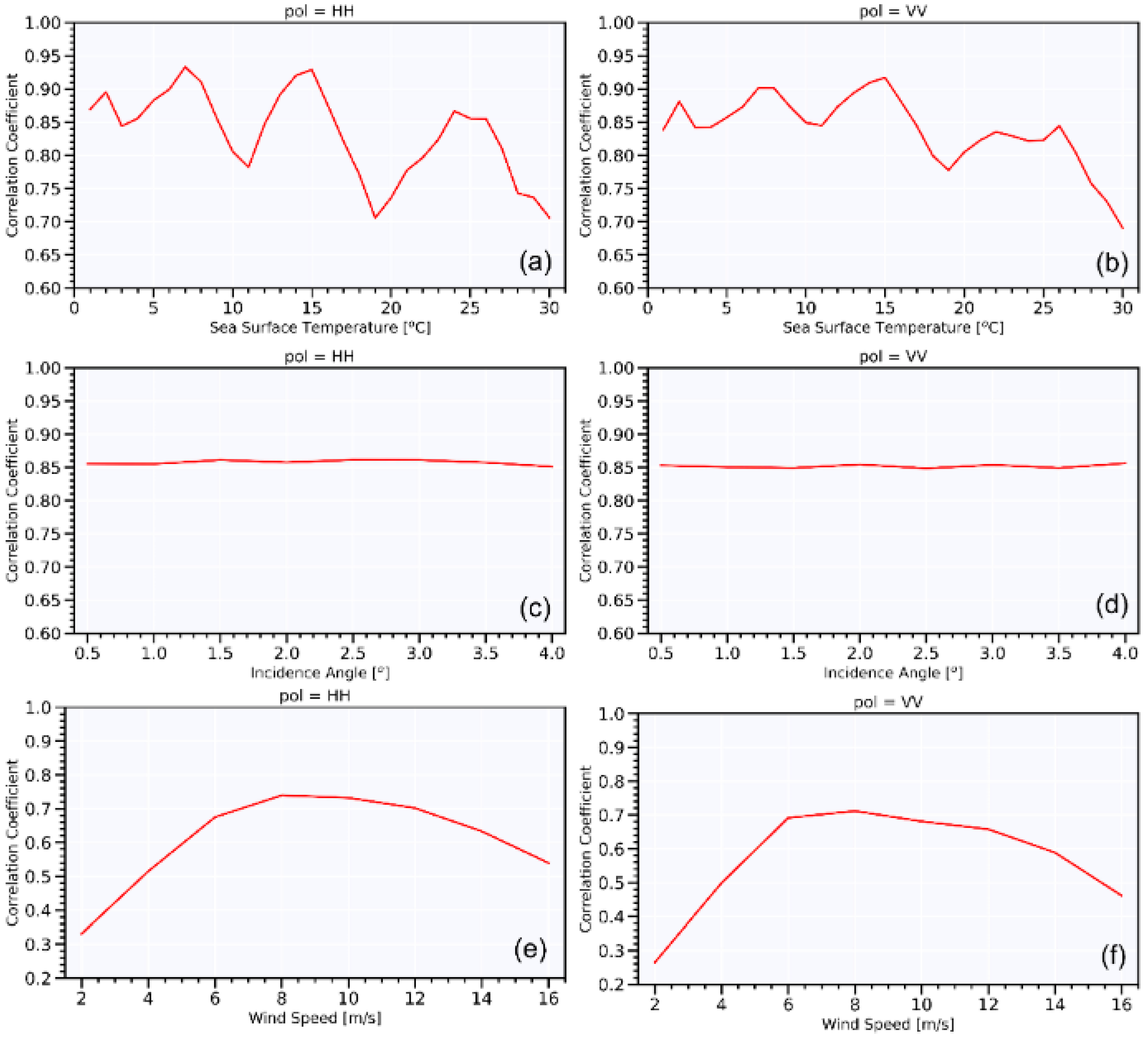
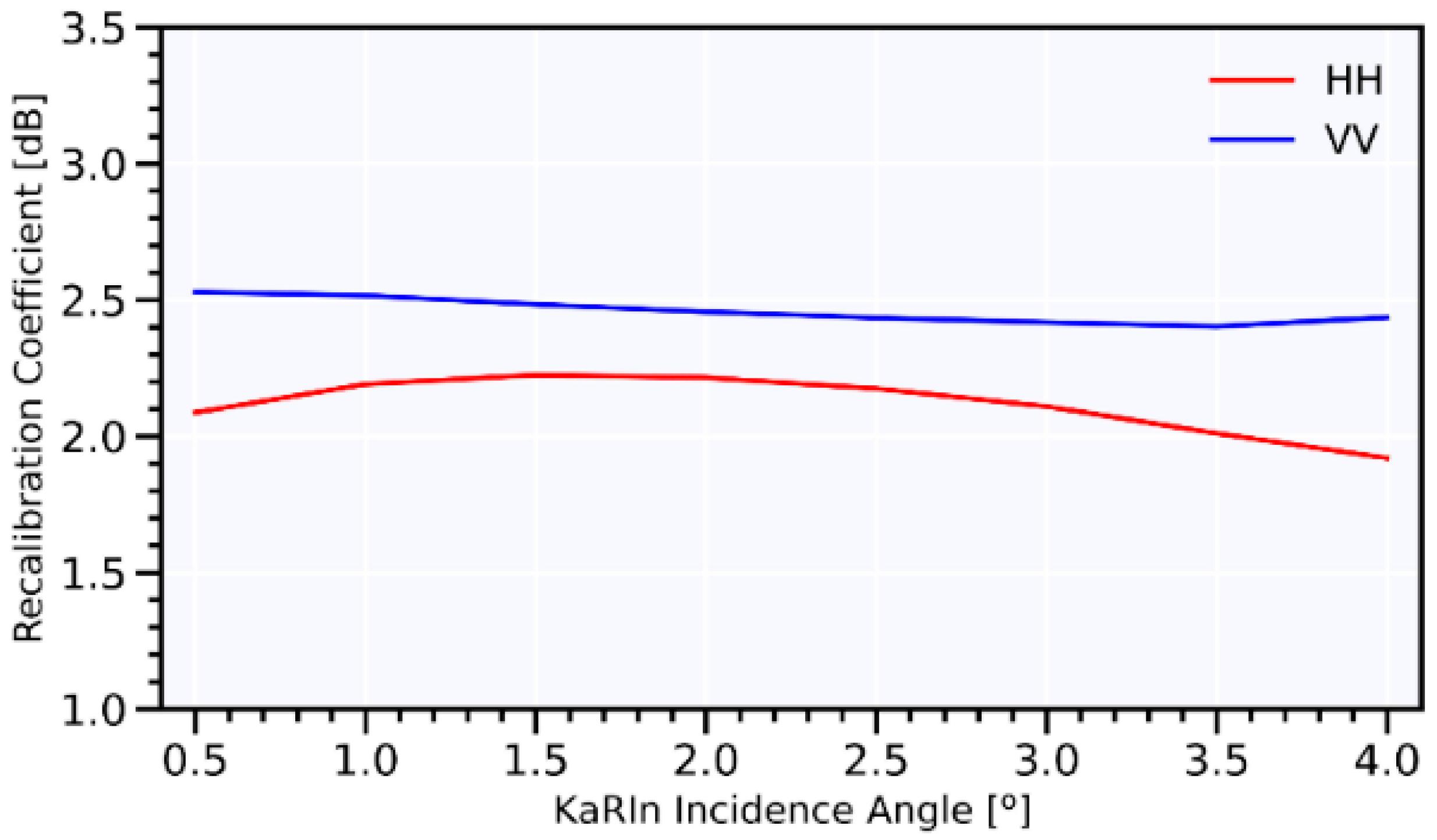
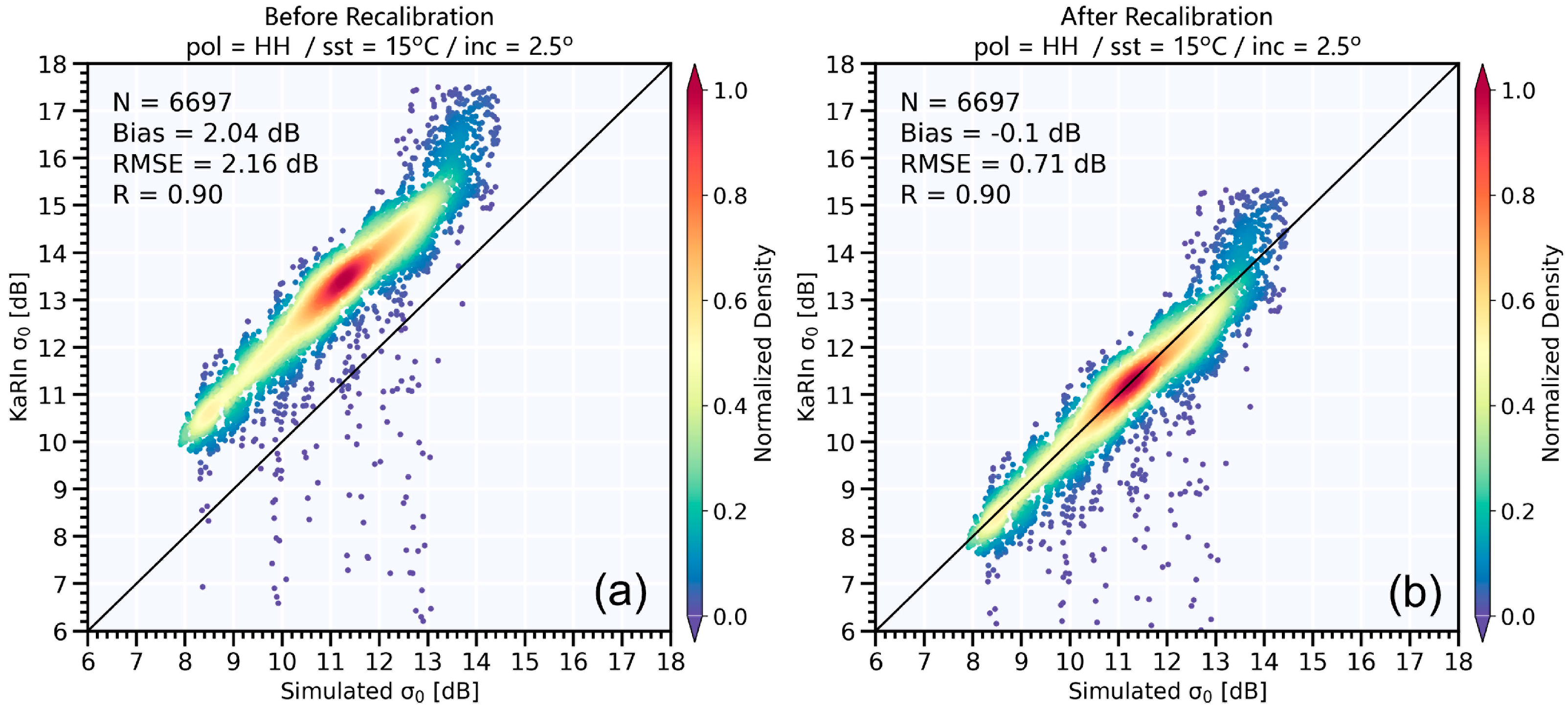

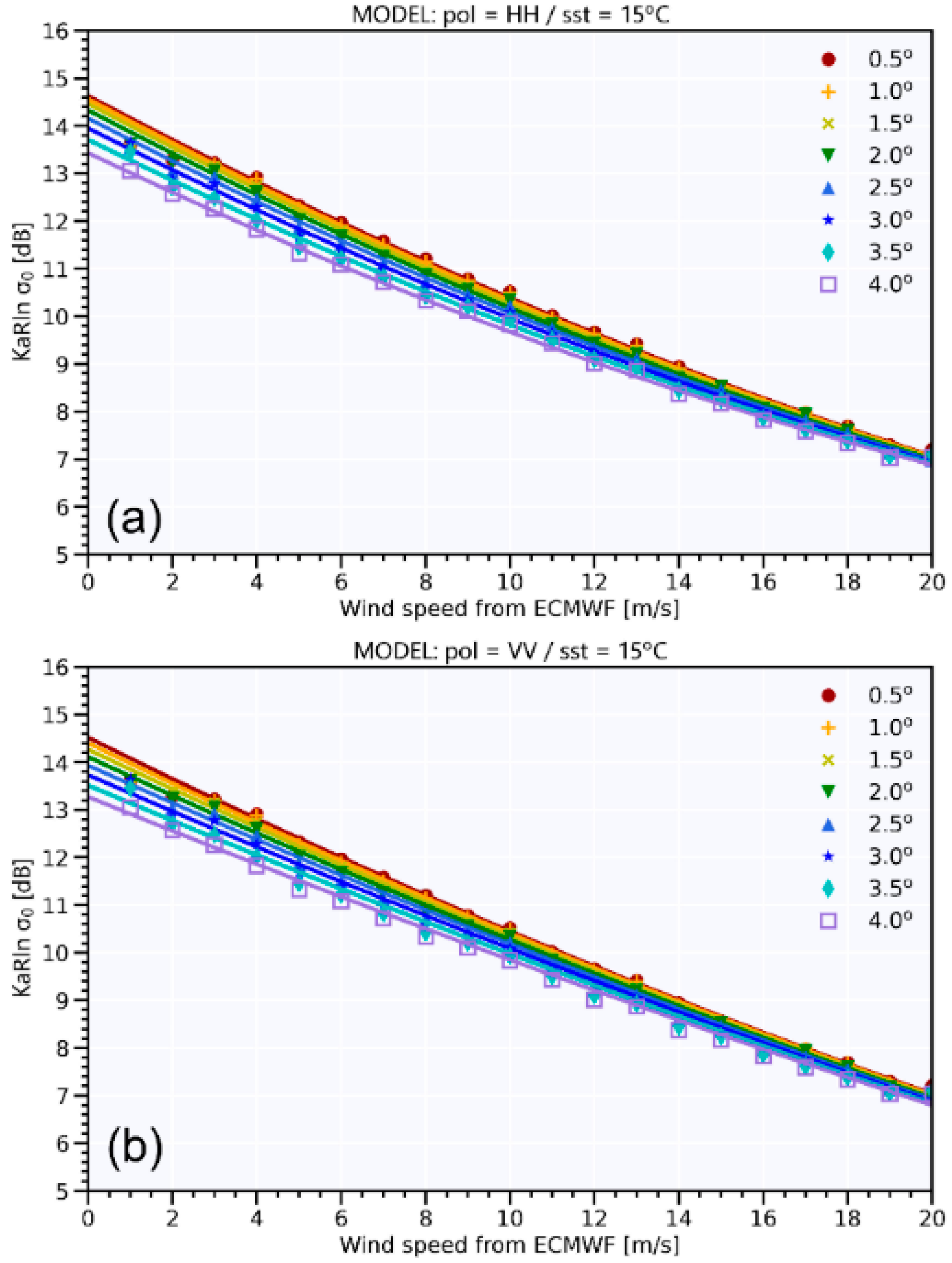
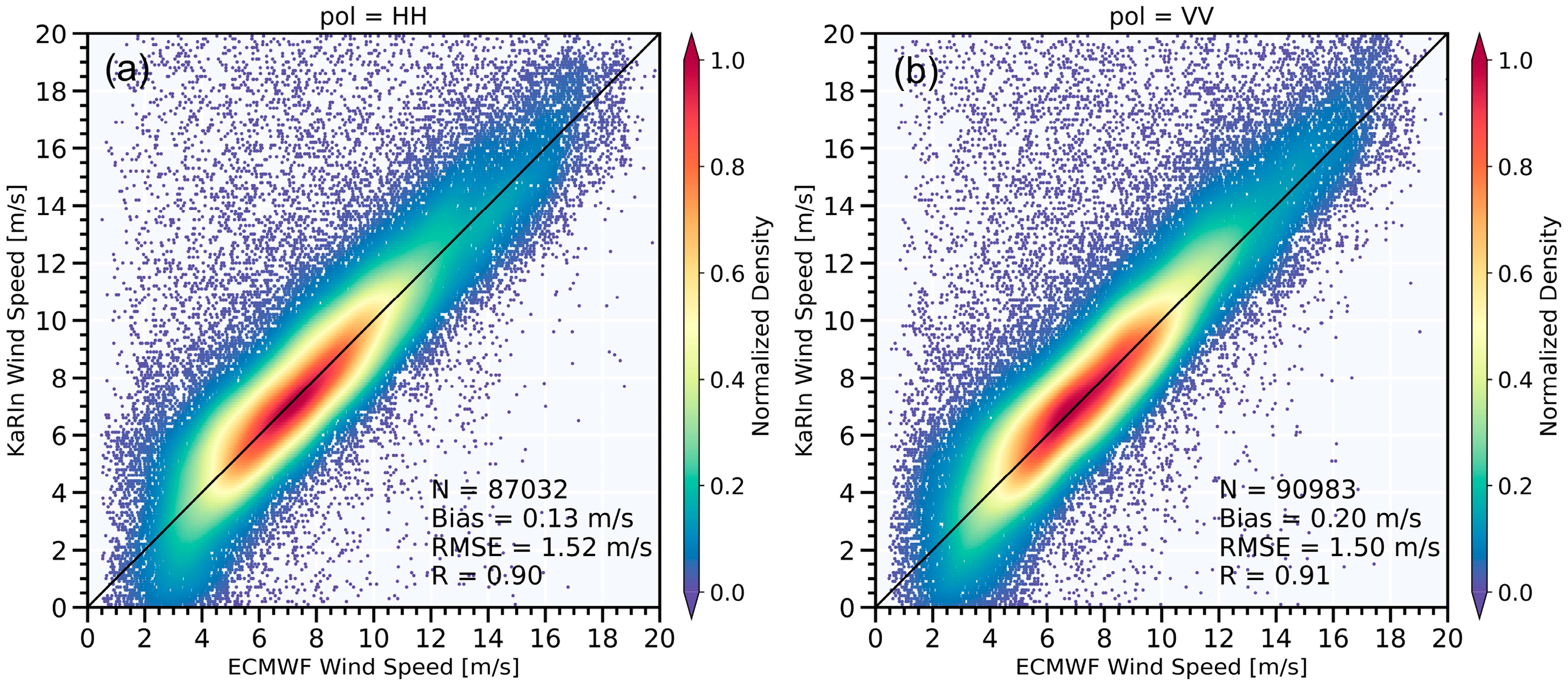
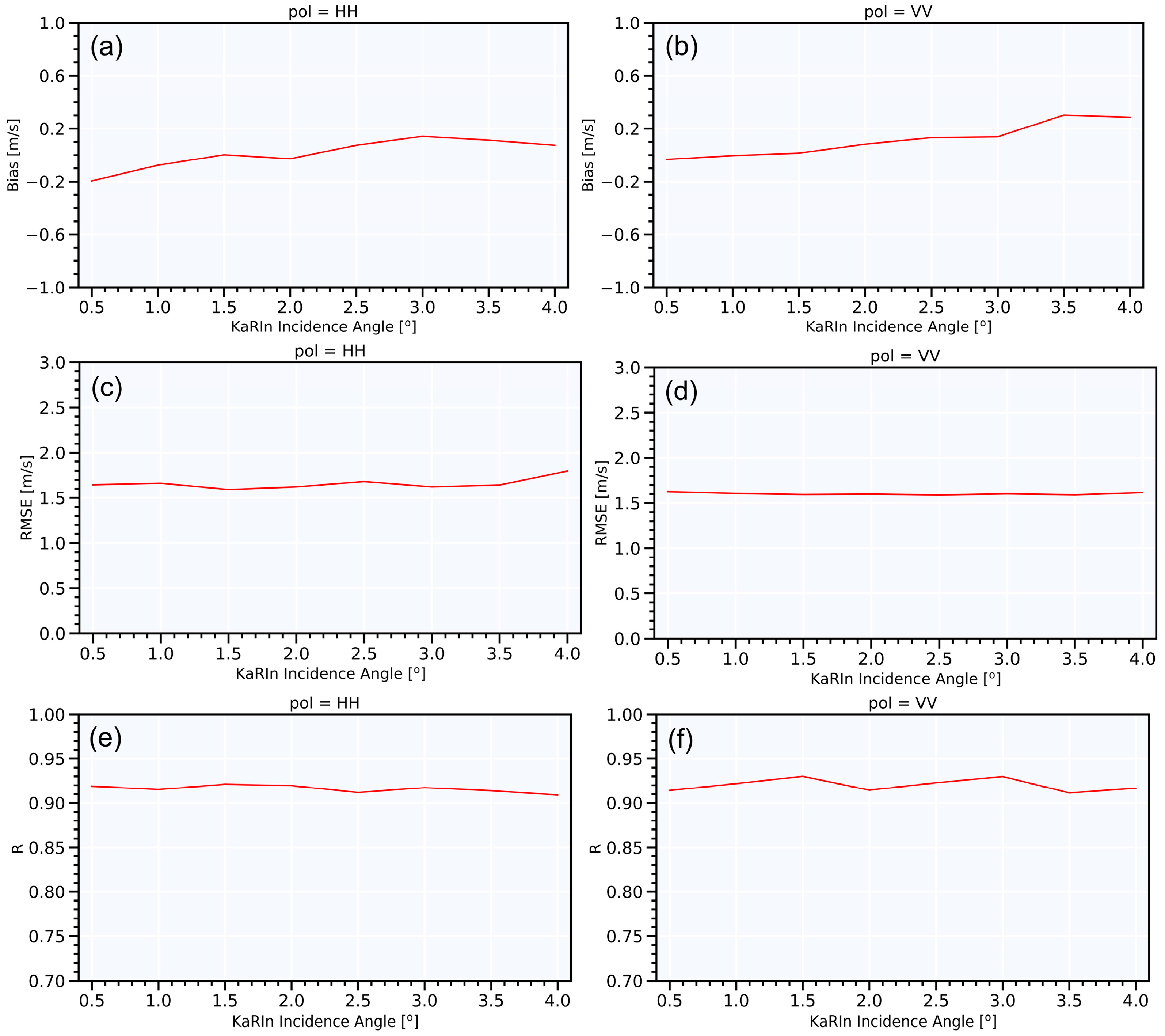
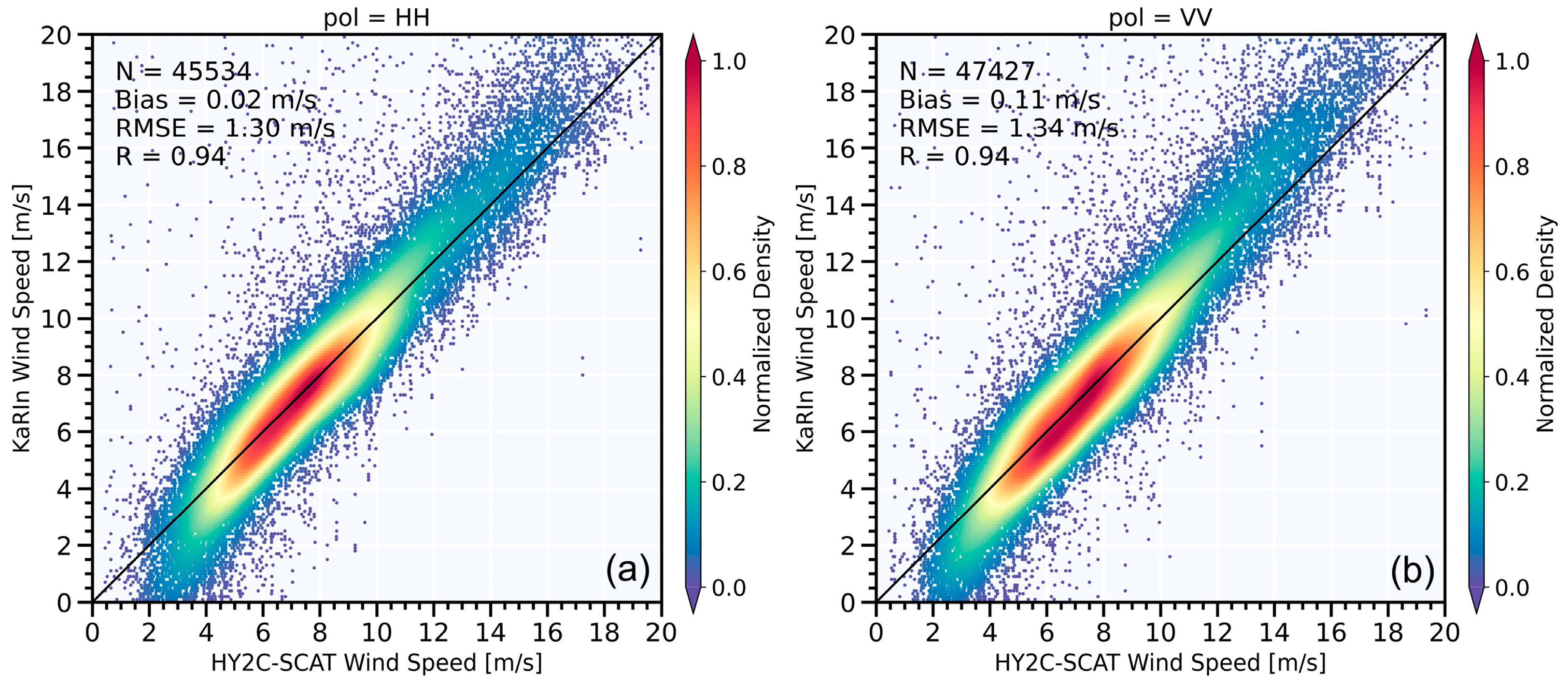
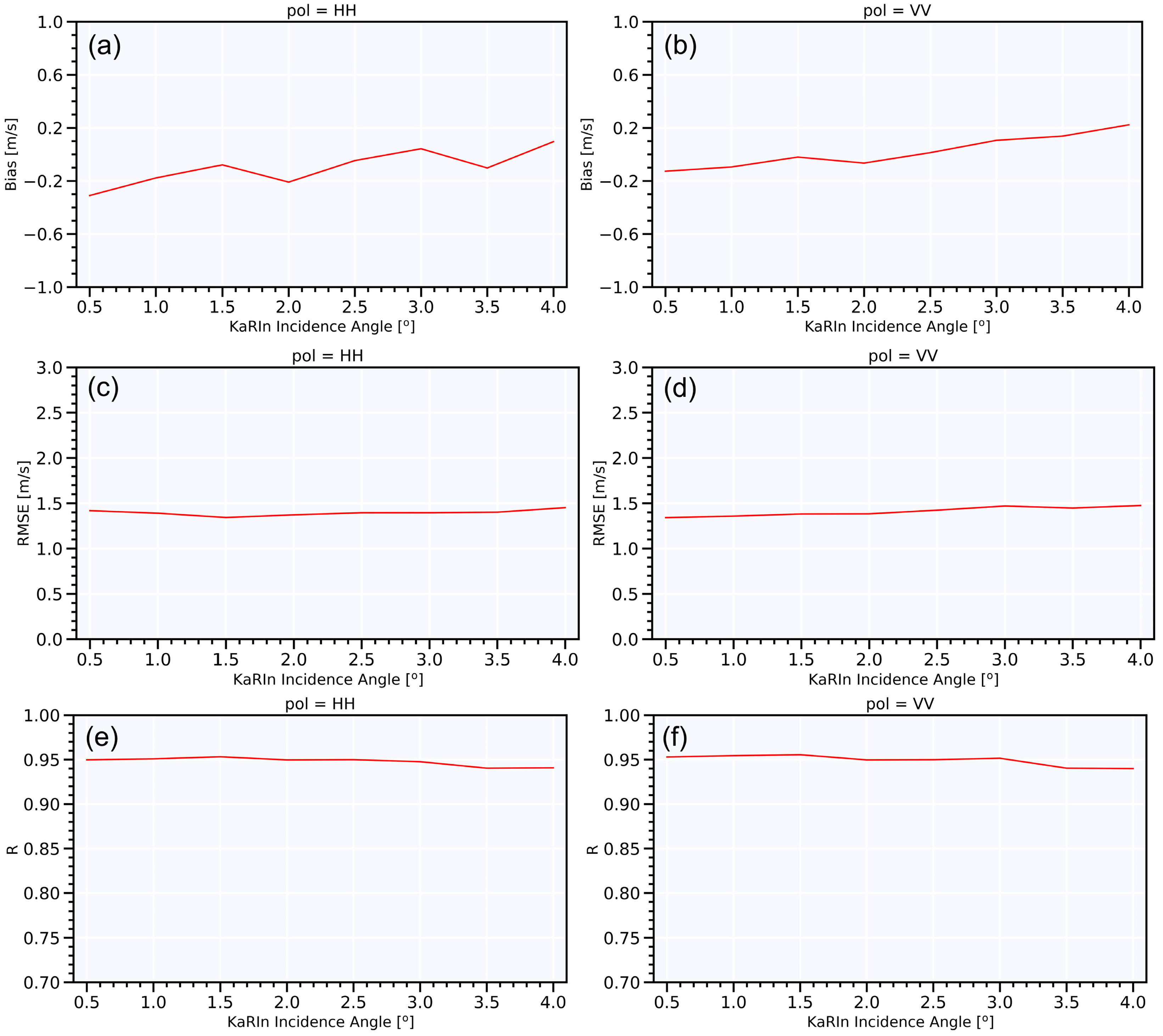
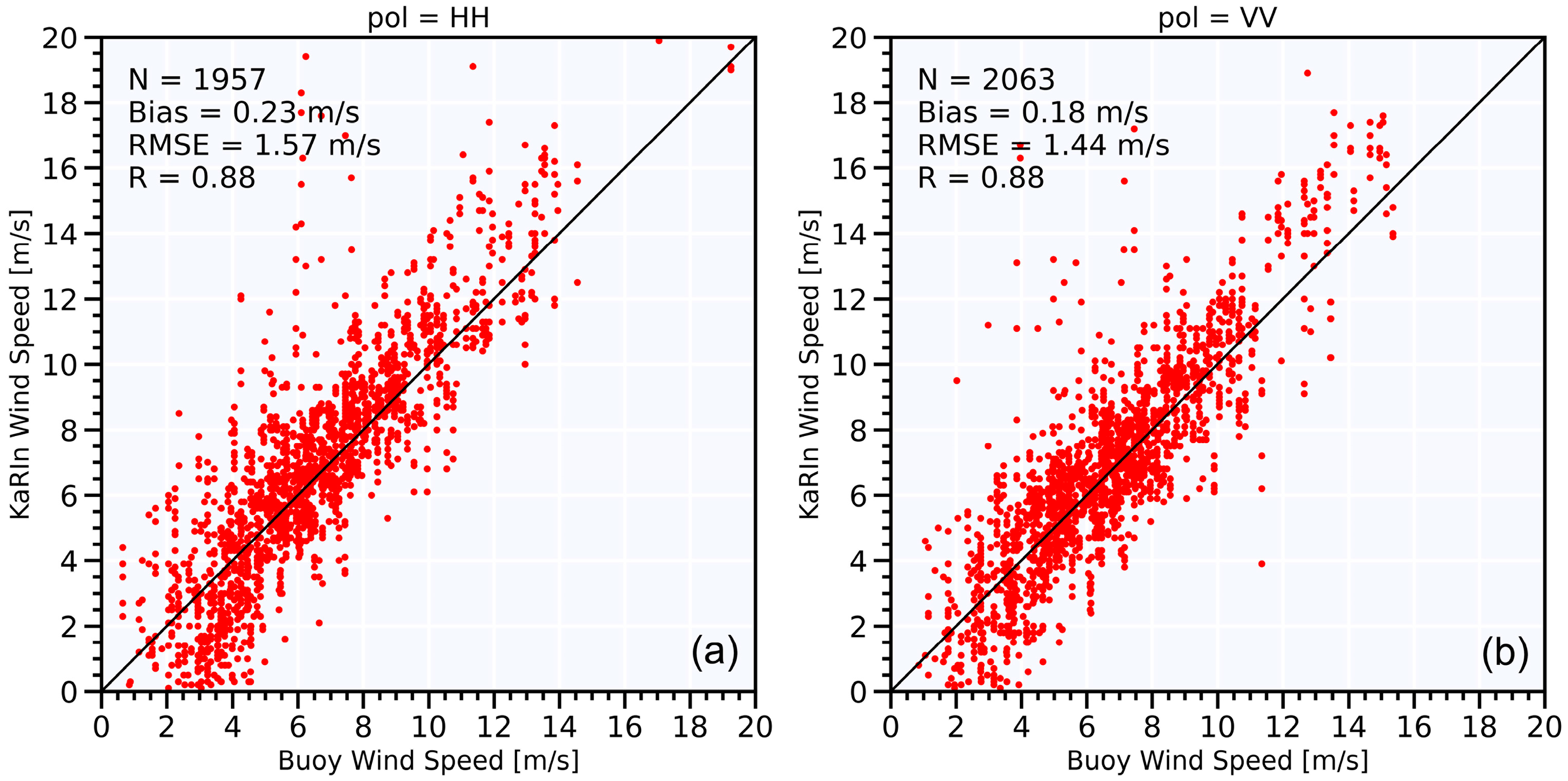
| p | sst | a0 | a1 | a2 | b0 | b1 | b2 | c0 | c1 | c2 |
|---|---|---|---|---|---|---|---|---|---|---|
| VV | 1 °C | 14.6133 | −0.1665 | −0.0420 | −0.4482 | 0.0161 | 0.0014 | 0.0035 | −0.0005 | 0.0000 |
| 8 °C | 14.7167 | −0.0301 | −0.0809 | −0.4512 | −0.0112 | 0.0082 | 0.0036 | 0.0007 | −0.0000 | |
| 15 °C | 15.7090 | −0.1543 | −0.0607 | −0.6252 | 0.0111 | 0.0057 | 0.01156 | −0.0003 | −0.0001 | |
| 23 °C | 15.8524 | −0.0282 | −0.1016 | −0.6302 | −0.0058 | 0.0132 | 0.0116 | 0.0002 | −0.0005 | |
| 30 °C | 15.4656 | −0.2534 | −0.0354 | −0.5198 | 0.0709 | −0.0078 | 0.0067 | −0.0056 | 0.0010 | |
| HH | 1 °C | 14.6611 | −0.0226 | −0.0712 | −0.4690 | −0.0068 | 0.0045 | 0.0045 | 0.0003 | −0.0001 |
| 8 °C | 14.7372 | −0.07.91 | −0.0784 | −0.4569 | 0.0073 | 0.0051 | 0.0037 | −0.0004 | −0.0001 | |
| 15 °C | 15.6130 | −0.0270 | −0.0973 | −0.6084 | −0.0057 | 0.0103 | 0.0106 | 0.0004 | −0.0004 | |
| 23 °C | 15.8815 | 0.0653 | −0.1086 | −0.6435 | −0.0248 | 0.0125 | 0.0123 | 0.0013 | −0.0004 | |
| 30 °C | 14.6472 | 0.1518 | −0.0989 | −0.2719 | −0.0709 | 0.0147 | −0.0092 | 0.0054 | −0.0008 |
Disclaimer/Publisher’s Note: The statements, opinions and data contained in all publications are solely those of the individual author(s) and contributor(s) and not of MDPI and/or the editor(s). MDPI and/or the editor(s) disclaim responsibility for any injury to people or property resulting from any ideas, methods, instructions or products referred to in the content. |
© 2024 by the authors. Licensee MDPI, Basel, Switzerland. This article is an open access article distributed under the terms and conditions of the Creative Commons Attribution (CC BY) license (https://creativecommons.org/licenses/by/4.0/).
Share and Cite
Ren, L.; Dong, X.; Cui, L.; Yang, J.; Zhang, Y.; Chen, P.; Zheng, G.; Zhou, L. NRCS Recalibration and Wind Speed Retrieval for SWOT KaRIn Radar Data. Remote Sens. 2024, 16, 3103. https://doi.org/10.3390/rs16163103
Ren L, Dong X, Cui L, Yang J, Zhang Y, Chen P, Zheng G, Zhou L. NRCS Recalibration and Wind Speed Retrieval for SWOT KaRIn Radar Data. Remote Sensing. 2024; 16(16):3103. https://doi.org/10.3390/rs16163103
Chicago/Turabian StyleRen, Lin, Xiao Dong, Limin Cui, Jingsong Yang, Yi Zhang, Peng Chen, Gang Zheng, and Lizhang Zhou. 2024. "NRCS Recalibration and Wind Speed Retrieval for SWOT KaRIn Radar Data" Remote Sensing 16, no. 16: 3103. https://doi.org/10.3390/rs16163103
APA StyleRen, L., Dong, X., Cui, L., Yang, J., Zhang, Y., Chen, P., Zheng, G., & Zhou, L. (2024). NRCS Recalibration and Wind Speed Retrieval for SWOT KaRIn Radar Data. Remote Sensing, 16(16), 3103. https://doi.org/10.3390/rs16163103






